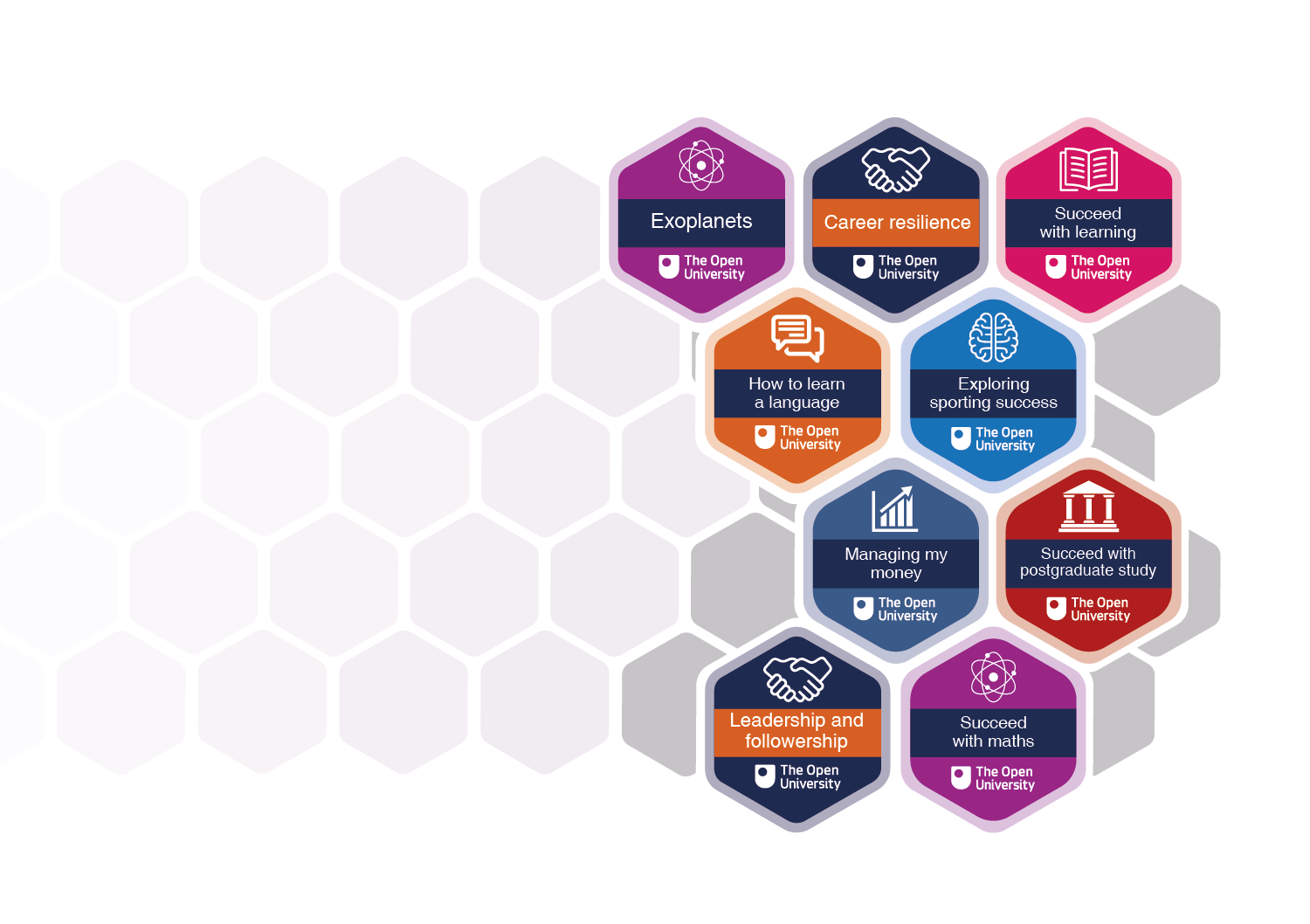Like other higher education institutions (HEIs), The Open University offer an increasing number of digital badges. These recognise students’ skills and knowledge gained from engaging in activities both within and beyond the taught curriculum, in a form which can be shared with current or future employers. However, even since the advent of the HEA Employability framework in 2015, digital badge offers by HEIs have been tentative (Knox and Stone, 2019). This has been linked to a ‘gap between what HE delivers and the employer needs’ (Ippoliti and Baeza, 2017).
Whilst most Open University badges are offered on our OpenLearn platform, principally earnt through completing badged open courses or summer schools, some link to other student activity such as peer mentoring, involvement in scholarship and, most recently, initiatives led by the Careers and Employability Services such as the Graduate Futures Skills Award and available for students completing internships. Further badges are offered on the OpenBadgeFactory platform, for example through courses in the Open Centre for Languages and Cultures and for students acting as ambassadors on Student Voice and Wellbeing Groups.
To inform the University in developing a strategy which embraces this activity:
- What do students, as potential badge earners, think about their value?
- What do staff, as both potential badge creators and earners, think about them?
- What do we know about what employers think, as potential badge users? If badges aren’t used by employers, then learners are unlikely to pursue them (Ahn et al. 2014).
 Badging Employability And User Perceptions: Evidence from Examples of Practice (BEAUPEEP).The University funded a pan-University scholarship project, which
included desk-based research followed by online surveys and evidence café
discussions with students, staff and employers to find out. The Badging Employability
And User Perceptions: Evidence from Examples of Practice (BEAUPEEP) project has
created a collection of materials which detail the findings curated at: https://ordo.open.ac.uk/account/home#/collections/6343157.
Badging Employability And User Perceptions: Evidence from Examples of Practice (BEAUPEEP).The University funded a pan-University scholarship project, which
included desk-based research followed by online surveys and evidence café
discussions with students, staff and employers to find out. The Badging Employability
And User Perceptions: Evidence from Examples of Practice (BEAUPEEP) project has
created a collection of materials which detail the findings curated at: https://ordo.open.ac.uk/account/home#/collections/6343157.
The main finding of the study was that there was a lack of awareness of open, digital badges; not only of their existence but also of their potential. Once students and employers, in particular, heard more about them, there was general excitement. This was quickly followed by a number of questions. The BEAUPEEP team reflected that it was easier to produce them, in pockets of activity across the University. What was needed was an overview of this activity, informed by those who might earn and use them.
So, what advice can we glean from students (aged from under 25 through to over 56) in the study?
- If students had these available they could be really excited ‘OMG! Gamification for the real world. I love this idea and would want this.’
- Reassure students that working towards badges won’t distract from main study priorities. 26.5% of the 117 student respondents, and a similar % of staff were concerned about this. Other students weren’t interested in recognising employability skill development within their modules. ‘Don’t waste module space and TMA marks on these.’
- Offer badges for extra curricular activities so that students can capture the extra time spent on these and the skills gained.
- If ‘People generally don’t know what to make of badges’, raise external understanding and awareness so that they are worth earning, especially if you are recommending we share them on social media, CVs and job applications. Offer them to everyone ‘It shouldn’t be optional as people don’t really understand what it is - like with all new tech!’
Open University students’ views linked to other studies flagging the dangers of assuming students will be motivated to collect badges for use in furthering their career. However, even if students aren’t interested in sharing badges, they can still be valued for supporting personal journeys of growth (Başal and Kaynak, 2020). When designing badges studies guide HEIs to evaluate how inclusive they are. Beware that, whilst the most motivated are most likely to complete them, it might be those who have felt excluded who might most benefit (Başal and Kaynak, 2020; Miller et al, 2020). Studies confirm that badges can be used to motivate students to study but beware their use to seed competitiveness with others (Alt, 2021) and embrace their potential to support a sense of community and belonging (Hartnett, 2021).
What did staff tell us?
- Make clear the purpose and value of digital badges. 25% of the 90 staff respondents could not see a relevance to their current role. Of all three categories, staff were the least enthusiastic about the concept of digital badging.
- However, 37.4% staff respondents agreed badges could be useful for capturing extra-curricular skills and a further 36.4% agreed could use in formal qualifications for skill recognition.
- Staff suggested uses for: employability, capturing evidence of module prerequisites, stage awards, as collaborative awards with industry lead bodies, and to support retention.
Other studies indicate that badges can support and track student progress as, if not earned, they can trigger alerts ripe for intervention (Harvey, 2017). However, there are dangers to consider, avoiding introducing additional pressures as a second tier of assessment (Anderson et al, 2017). Staff concerns that badges are in danger of being ‘gimmicky’ are held elsewhere (Anderson et al, 2017), making staff sceptical of investing time in developing them. Pockets of enthusiasm and badge development as found in the Open University are reported elsewhere (e.g. Els et al, 2017). Staff feeling badges for skills were more valuable than those for participation has been confirmed in other studies (Carey and Stefaniak 2018).
Employers, from a range of sectors, offered further insights:
- 71% of the 31 respondents didn’t currently use badges in recruitment or staff development
- Employers said that their views on the value of badges ‘depend on what evidence is held within the badge that shows me the holder can actually do the things the badge claims.’
- Employers consider Universities (13%) as less important than other providers such as professional bodies (37%) and industry leading companies (40%) and hence recommend endorsements from partners (as also studies Rizvi, 2016, Laverie et al, 2020).
- Make clear what the badge has been awarded for as orientation. If they have been awarded ‘simply for a quiz pass or isolated example of a competence then it’s going to be no more useful than any other claim made by an applicant on their CV’.
Employers in the study explained that, whilst badges can demonstrate applicants have something distinctive to offer, if everyone has them, then this will dilute their value to students, as captured by Miller et al (2020). Studies warn that, for badges to be captured through increasingly digital recruitment processes they need to read by screening tools (Perkins and Pryor 2021), and so need to be mapped against recognisable search terms.
In summary, there is enthusiasm by students and employers for digital badging. However, attaching value and credibility to digital badges can only be achieved if students, staff and employers understand the benefits and limits to badges and know how to use them effectively. Credibility may be mitigated by developing credentialling systems, and co-design across stakeholder sectors. The emotional connection between badges with pin badges and other merit badges from childhood can both be an attraction (stirring childhood enthusiasm for marking learning) and a challenge (if they are considered likely to be less credible) (Glover, 2016).
The 10 recommendations from the BEAUPEEP project centre around raising awareness of digital badging:
- Advertise – Raise awareness of the purpose and potential of badges – for employability, community building, personal interest, motivation/retention
- Offer – Offer a wide range of badges showing choice, connectivity and progression
- Advertise – Communicate the content of badges and the criteria in meaningful ways, including year and valid to date if relevant
- Support – Support students in making the most of their badges, including mechanisms for making the badges and their criteria visible eg LinkedIn
- Advertise – Capture at a glance how badges fit into a bigger picture of badge delivery - at module, programme, School, Faculty and University levels
- Design – Design for credibility and validity, including mechanisms for checking badge criteria are of value, have been met and include OU logo
- Check – Ensure badge criteria are fully inclusive and ensure criteria can be feasibly met by all
- Promote – Consider how to increase badge criteria visibility to employers e.g. key terms in criteria, scanning of CVs and other AI solutions
- Consider – Consider multiple languages in design, use and promotion
- Think about – Think about how we can contribute to evaluating digital badges across the sector
If you are a student or member of staff and are interested in knowing more detail about the range of badges available, please contact beaupeep@open.ac.uk and we will point you to relevant contacts and initiatives.







Rate and Review
Rate this article
Review this article
Log into OpenLearn to leave reviews and join in the conversation.
Article reviews